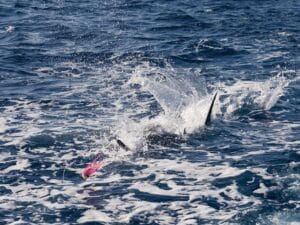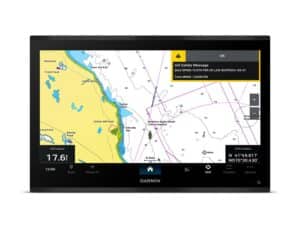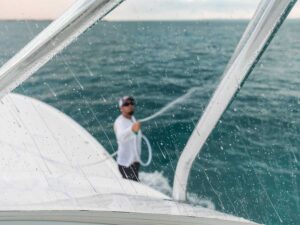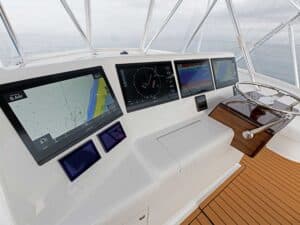
For the past five or six years, integrating audio-system control through multifunction navigation displays has been the hottest trend in audio — and it’s not cooling off, especially in large battlewagons.
Fusion Entertainment was first to integrate audio systems through MFDs, and it did so with Navico, the parent company of Lowrance and Simrad. “We came up with an idea to create control at the MFD,” Todd Crocker, the company’s U.S. sales manager, says when describing its Fusion-Link system. “The auto market was already doing it, and we thought it was needed on boats.”
But it was easier in cars because everything is controlled by one manufacturer. In marine applications, there are multiple platforms on any one boat. So Fusion quickly seized on the only common element in marine electronics:
the NMEA 2000 data bus. This system, too, was rampaging through boats from 18 to 180 feet and longer. The system pipes parameter group numbers, essentially digital sentences, that travel from the data bus and command the display system as well as things networked to it.
With Simrad’s permission, Fusion created PGNs to control volume, balance, tone and bass in up to four zones. The ability to control separate zones was particularly useful for sport-fishers that have a cockpit, salon, staterooms and a bridge because those on board may want different volume settings or no music at all in those different areas. To offer separate zones different listening options, additional source units are required.
“We came up with an idea to create control at the MFD. The auto market was already doing it, and we thought it was needed on boats.”
Todd Crocker, U.S. sales manager, Fusion Entertainment
Advertisement
Everybody Wants to Play
Soon, all electronics manufacturers using the NMEA 2000 protocol were offering Fusion access to their operating protocol for integrated stereo controls. Fusion-Link is proprietary and, with the exception of partnering with Navico to create SonicHub (a Navico audio product used most often with smaller inshore boats), Fusion has guarded its system carefully. The demand for networked equipment grew and netted Fusion what some say is currently between 50 percent and a whopping 98 percent of the marine market.
Then Garmin bought Fusion, and three of the “Big Four” marine electronics makers — Furuno, Simrad and Raymarine — turned to NMEA to develop standard PGNs to allow audio companies to talk to NMEA 2000-equipped navigation systems. First it was Rockford Fosgate, then JL Audio, and finally Polk Entertainment. Initially, those companies feared the Garmin acquisition would restrict their access to the Fusion-Link system. Raymarine brought Rockford Fosgate into the fold a year ago, and Garmin issued firmware updates that enabled JL, Rockford Fosgate and Polk to operate in its stable last October. It now appears that nearly all of the companies will be able to network to everybody else in a year or so — if they want to. But should you?
Why Network?
Turns out, that’s a personal question. First, you have to define your expectations. Some boatbuilders and boat owners like integrating audio controls to eliminate yet another penetration through the helm station or other bulkheads. Others like the clean, uncluttered look of an all-glass helm that gives the ability to access engine data, autopilot, audio and more through the glass MFDs. Another benefit to networking is the elimination of a bird’s nest of wires: One NMEA 2000 cable linked to the data bus powers and communicates with the system. This streamlines the installation and eases maintenance. Finally, some just like leaving more real estate open on an already busy helm station.
These are all great advantages, but what is the downside? As one offshore boatbuilder put it succinctly, “I don’t like to put so many eggs in one basket.” And that’s a valid point, especially if integrating the audio system means you eliminate a dedicated source unit control on the bridge. If a display goes down, so does music control. Until recently, Polk audio systems did not integrate, yet yachtbuilders still selected them. This is partially because their unique source controller is waterproof and very compact, yet robust. It is an easy matter to wire relatively inexpensive controllers or remotes in each area, creating redundancy and the ability to control volume in a particular area, and it is done without tapping the NMEA 2000 bus.
If you choose a dedicated controller at the helm, networking makes better sense. First, the skipper can quickly control audio when needed through the MFD, but a dedicated controller also lets a mate control audio without interfering with navigation. It can be a pain to have the self-appointed DJ constantly squeezing in behind the helm just to change the tunes.
On the real-estate question, ask yourself, where is it most precious? The answer is most likely on the navigation displays. Now that propulsion systems, autopilot and other functions are displayed or controlled on the glass helm, how much more do you really want to divide up your display? And what is the benefit of touchscreen display for audio control?
Zone control was the main advantage offered by Fusion’s Fusion-Link software, and Fusion was the only one to have it until the display makers offered new NMEA 2000 firmware. It was easier to address the zone control on the display rather than on the source unit. Now, JL Audio will offer zone control on its MM100s source unit, and we expect others to catch up. Another advantage of integration with the MFD is the ability to browse playlists with better song-by-song visibility on the larger screen so that making a selection is easier.
The Players
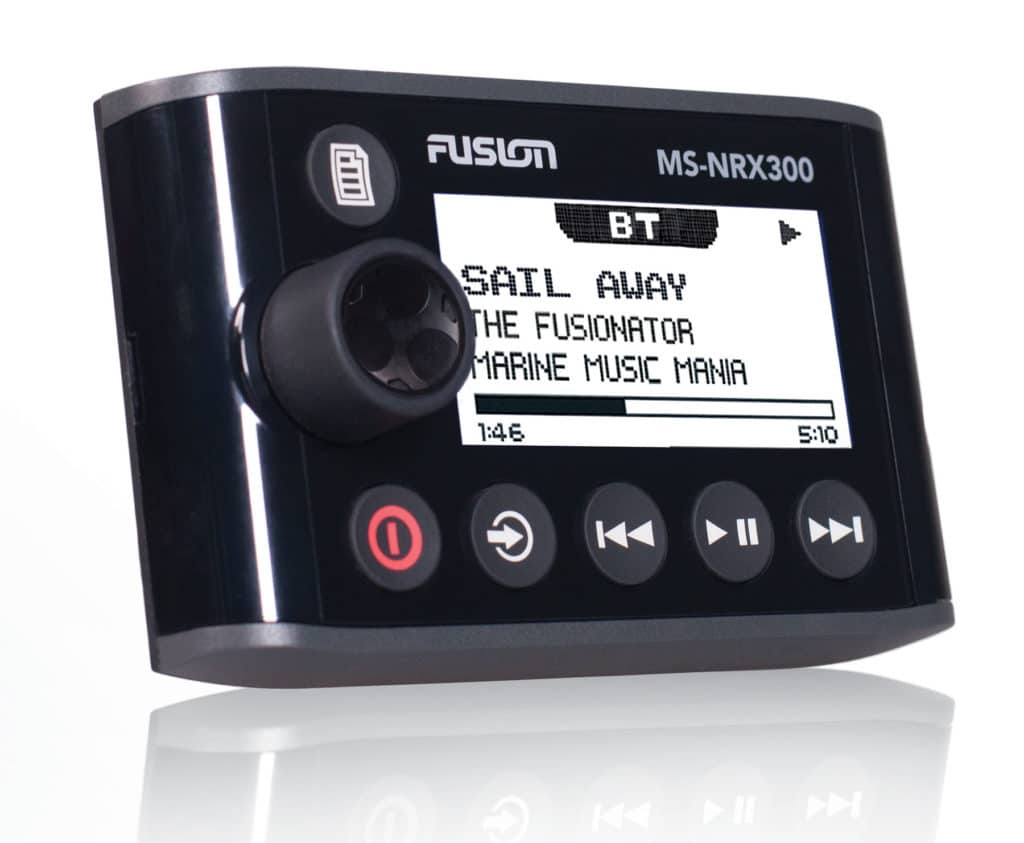
Fusion MS-AV750 and MS-NRX300 Remote
Fusion was the first to integrate with proprietary Fusion-Link protocol built into the source units, eliminating a black-box bridge to the network. The MS-AV750 gives the user plenty of breathing room to access controls without taking up too much space at the helm. Some skippers fix the MS-NRX300 remote at the helm and position the MS-AV750 elsewhere — say a spot where there is no navigation display available. It is currently compatible with Furuno, Garmin, Raymarine and Simrad.

Polk Entertainment PA4A
This proven system now has the capability to integrate with Garmin, Simrad and Lowrance devices via the NMEA 2000 network. We won’t be surprised to see Raymarine announce compatibility soon. The advantage is the compact yet robust controller with a remotely mounted source unit. Polk’s system requires an optional gateway device to integrate, but it can be conveniently installed nearly anywhere.

Rockford Fosgate PMX-3
This recently introduced source unit has an IPX6-rated water-resistant 2.7-inch color display, giving it a good balance between compactness and ease of use. Rockford was the first to make a run at Fusion’s corner on the audio integration playing field by using the NMEA 2000 network through its black-box gateway.

JL Audio MM100s
The MM100s initially disappointed users when first introduced last year because it lacked zone control. That has been added to the NMEA 2000 PGNs, however, and the combination of this roomy color control panel and MFD functionality now makes JL a full audio and one-stop spot for speakers, amp and source units. It is currently compatible with Garmin and Simrad.
